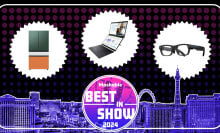Over the last few years, the market for extended reality (XR) devices has expanded significantly. While earlier forays like Google Glass failed to take off, recent additions like the XREAL (formerly Nreal) Air 2 — and the just-released Apple Vision Pro — have shown far more promise, leaving many consumers excited about the future of extended reality.
And for me? I’ve spent years diving headfirst into XR devices, constantly looking for the next big thing. From virtual reality (VR) headsets to augmented reality (AR) glasses and everything in between, I’ve been impressed — and disappointed — by many different options on the market…which is why I jumped at the chance to try the TCL RayNeo Air 2 glasses for myself.

Marketed as an “upgraded and enhanced” version of the TCL NXTWEAR S+ smart glasses, the RayNeo Air 2 glasses tout some pretty impressive specs, including:
1080p Sony Micro OLED displays
A massive 201-inch virtual screen size
600 nits brightness
Super-fast 120Hz refresh rate
However, while the RayNeo Air 2 glasses sound like an impressive contender in the burgeoning XR/AR glasses space, they also come with quite a few problems.
First impressions of the RayNeo Air 2 glasses
Straight out of the box, I wasn’t sure what to think about the RayNeo Air 2 glasses. Like many other AR glasses, the RayNeo Air 2s have a shape reminiscent of classic Wayfarer sunglasses, but they’ve added a futuristic edge. While the look is cool in photos, the execution didn’t quite meet my expectations.
The front of the glasses is a single black piece of plastic that’s very shiny and reflective. It looks to be attached separately to the rest of the glasses — almost like the lens has been glued to the front versus set inside frames — which isn’t my favorite. Some people might like the look of these glasses, but it feels more like a novelty product than a sleek and stylish choice. Plus, given that there’s no “frame” on the front side of the glasses, every smudge and fingerprint is easily visible on the lens.

All in all, the rest of the build feels underwhelming. The glasses are lightweight and pretty comfortable, but the overall aesthetic of these glasses is lacking compared to other brands I’ve tried. They have most of the standard features: adjustable nose pads, flexible temples, and the option to order magnetic prescription inserts. However, they’re also pretty plasticky. The earpieces are rigid and stiff, the nose pads are hard to move, and the earpiece's physical buttons — one for volume and one for brightness — speak to a design focused more on features than functionality.
Even the carrying case was a letdown. Unlike other AR glasses I’ve tried, the RayNeo Air 2s come with a cloth bag instead of a hard case, making the entire experience feel a little lackluster for the price.
What I liked about the RayNeo Air 2 glasses
The RayNeo Air 2 glasses work decently well as a plug-and-play portable external display. They offer a decent field of view, and the Sony Micro OLED displays allow you to reach an impressive screen size of up to 201 inches, with a super-fast 120Hz refresh rate and great brightness level.
The glasses use an included USB-C cable to connect to your device, and they’re compatible with iPhone 15 and Android devices with DisplayPort out functionality. There is a separate adapter that you can purchase to use with other devices — one that works for Nintendo Switch and another for older iPhones and non-DP Android devices — but both are sold separately.
Because these glasses don’t have a built-in battery, getting started with them is pretty easy. You simply plug them into a compatible device — I used my Samsung Galaxy Note 20 Ultra — and Samsung DeX takes care of the rest. It was easy to scroll through my phone, watch movies, and enjoy the convenience (and privacy) of a personal external display without any unnecessary bells and whistles. That being said, the lack of a battery also means that the RayNeo Air 2 glasses are pulling power from whatever device you’re using, so you won’t be able to charge your device while it’s plugged into the glasses (unless you have a wireless charger of some sort).
What I didn’t like about the RayNeo Air 2 glasses
As impressive as some of the specs are, the RayNeo Air 2 glasses were riddled with issues. The screen itself was large and super bright, but the outside edges of the screen were warped and blurry on the left and right sides — making it difficult to use the glasses in full-screen mode on DeX. The glasses also sat pretty far from my face, and the nose pads were hard to adjust, meaning a fair amount of light came through around the edges. This made the viewing experience less immersive, even though the glasses did have an impressive screen size.

The RayNeo Air 2s were darker than most AR glasses I’ve tried. While this is good for visibility and contrast, especially if you’re using the glasses in a brighter environment, it makes using them as AR glasses almost impossible. There’s no real head tracking or AR functionality that I could find, so when you enter full-screen mode, the screen is stationary. Instead of being able to “lock” the screen into position in virtual space, moving your head while wearing the glasses means the screen moves with you. And, because of how dark the lenses are, you can barely see through the screen to the real world. Other manufacturers of AR glasses have worked around this by making the lenses more transparent while including a separate clip-on cover for a darker viewing environment.
Unfortunately, the built-in speakers weren’t great either. The sound was clipping, especially at higher volumes, and the speaker quality was nowhere near as good as other AR glasses I’ve tried. I found it pretty easy to connect them to other devices like my iPad — I just plugged my iPad into the TLC portable adapter ($90) using the included lightning to USB-C cable and then plugged the glasses into the adapter. However, using the adapter and the mirroring app with non-DP Android devices was frustrating. The app was incredibly glitchy on my Samsung Galaxy Tab S9 FE+, and it frequently froze and needed to restart. Plus, the adapter itself felt very clunky and cheaply made, especially since it was bigger and more expensive than other adapters I’ve used (like the $49 XREAL Adapter).
Are the RayNeo Air 2 glasses worth it?
Not really. While seeing more options in the burgeoning XR market is exciting, the RayNeo Air 2 glasses didn’t cut it for me. They worked decently well as a portable external display, but — for the price — plenty of other options are available that have similar specs, better features, fewer problems, and more potential.
That being said, the RayNeo Air 2 glasses have some fantastic specs. The 120Hz refresh rate would’ve been great for gaming, the screen size is incredible, and the 600 nits screen brightness is excellent. However, almost every “plus” about these glasses immediately loses to downsides. The compatibility is limited, the screen is blurry and warped, and the darker lenses are a hassle.
Overall, the RayNeo Air 2 glasses still feel like a work in progress. They’ve got a few things that are a step in the right direction, but the rest feels like they’ve sacrificed what makes a device actually wearable so they can market specific specs. On paper, this makes the RayNeo Air 2 glasses promising. In reality, they’re barely passable.
At $379, the RayNeo Air 2 glasses have a similar price point to other AR glasses on the market, but the drop in quality is noticeable. They have many of the same issues I had with the original XREAL Air glasses — for example, they’re more like a flat monitor glued to your glasses versus an actual augmented reality experience — but they pale in comparison to newer options on the market. If you’re on the fence, I’d wait to see what TCL releases next or stick with the upgraded XREAL Air 2 glasses. They’re only $20 more than the RayNeo Air 2, but — at least for me — the quality difference is well worth the splurge.
















